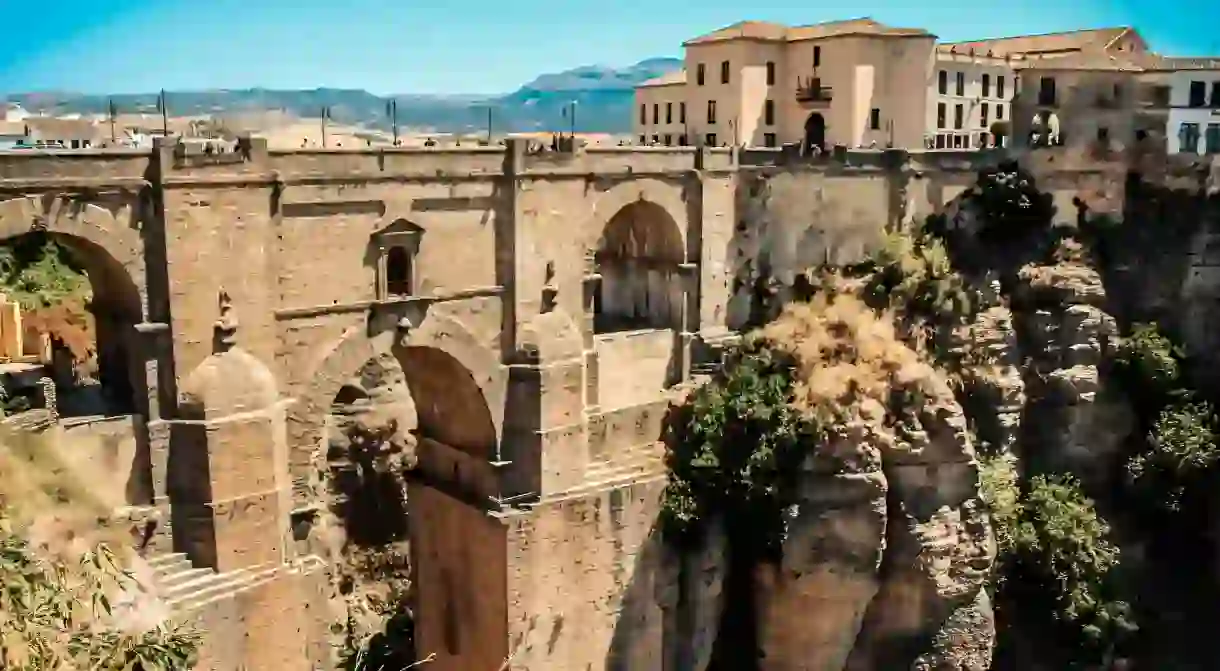The 20 Best Things to See and Do in Ronda

Steeped in dark myths and bullfighting folklore, whilst boasting one of the most extraordinary locations in Spain, it is small wonder that Ronda has become Andalusia’s third most visited town. With its world-famous New Bridge and bullring, as well as the hidden corners of the gorge on top of which it perches, Ronda will not disappoint.
New Bridge
Bridge

Bullring & Bullfighting Museum
Museum

Paseo de Ernest Hemingway
La Casa del Rey Moro (Moorish Palace)

Walking in El Tajo
Natural Feature

Either side of Puente Neuvo there are scenic walking routes to the bottom of El Tajo canyon. On the side of the old town, a little country path takes you down the hillside and under the great bridge itself, via some slightly hairy sections that resemble a much lower but less well-maintained version of Malaga’s terrifying Caminito del Rey. On the side of the newer part of town, a better-maintained pathway takes you across one of the quaint older bridges that New Bridge was meant to improve upon, and back up the other side of the gorge past the Casa del Rey Moro. Both of these undemanding walks provide an abundance of spots from which to contemplate the untamed beauty of Ronda’s location.
Old and New Town
Architectural Landmark

El Tajo canyon not only rendered necessary Ronda’s most iconic attraction, it also divides the town into two separate halves, each with its own style and atmosphere. La Ciudad – or The Town – is the original Moorish part and weaves around one central Street, Calle Armiñan, south of Puente Nuevo. The best time to explore this ancient barrio (Ronda was under Muslim dominion from 712 to 1485) is in the evening or at night, when the coach-loads of tourists are in their restaurants or hotels on the other side of the canyon. On the northern cliffs of El Tajo is the more commercial part of town, known as El Mercadillo – or The Little Market – it was developed after the Arabs were expelled towards the end of the fifteenth century. The heart of modern-day Ronda has retained all of the beauty and charm of Andalusia’s gorgeous ‘white villages’, even if its Plaza España is now home to a McDonalds.
Baños Arabes (Arabic Baths)

Eat and drink
Restaurant
Bird watching
Natural Feature

If you can bring yourself to inch onto one of the precipitous balconies overhanging El Tajo canyon, they provide a perfect spot from which to try and catch sight of some of the area’s beautiful airborne wildlife. The gorge that splits Ronda in two is ideal hunting and nesting ground for its many species of bird, among which are eagles, kestrels, falcons and the menacing Griffon Vulture, which has a giant 9-metre wingspan. Ronda’s clifftop location allows you to feel part of these magnificent birds’ natural habitat in a way you rarely can at less stomach-churning heights.
Puente Viejo
Bridge
Jardines De Cuenca
Park
Named after Ronda’s twin Spanish city, these stunning gardens are staggered down the eastern side of Puente Nuevo, leading to that famous crossing’s older and smaller brother. Best visited either during the morning, before it gets too hot, or at sunset, they offer jaw-dropping views of El Tajo canyon, Puente Nuevo and the fertile landscape south of Ronda.
Alameda del Tajo
Natural Feature

Andalusia’s most stunning park is located just behind Ronda’s historic bullring. Particularly beautiful during spring and autumn, the Alameda del Tajo features several viewing platforms that hang over the cliff edge; hilariously, Spaniards call these coño balconies, coño being a versatile Spanish swearword that you may well want to use upon looking down.
Grazalema Natural Park
Park

Las Nieves Natural Park
Park
Bar El Lechuguita
Bar
For fast and cheap tapas surrounded by locals, El Lechuguita is your place. Nestling on a sidestreet just off Plaza España, this hugely popular joint flings out bite-sized treats for as little as 80 cents, while the more ‘expensive’ tapas will set you back two or three euros. It’s traditional fare – think grilled meats and tortilla – and it’s very small, so arrive early to avoid disappointment.
Mondragón Palace
Building, Museum

Mesón El Sacristán
Restaurant
Don’t leave Ronda without treating yourself to a meal at Meson El Sacristán, one of the town’s stand-out restaurants. Its USP is a gorgeous old wood oven, in which a variety of mouthwatering, locally sourced meat dishes are cooked. Star platos here are the roasted suckling pig, the baby goat chops and the stewed bull’s tail, a Rodeño classic. The restaurant is also famous for its world-class cured jamons and its homemade desserts.
Restaurante Casa María
Restaurant
Casa Maria likes to surprise its clients. You don’t order off a menu here: you simply take your table, order the drinks and let the kitchen staff serve you several courses made from whatever was freshest at the market that morning. This ingredient-driven approach to cooking has made Maria’s House extremely popular, so be sure to book in advance. Order the fabulous lemon cheesecake for dessert.
The Lara Museum
Museum
September Festival
Architectural Landmark
Come early September, Ronda throws itself into its annual Pedro Romero festival. Named after the legendary 18th-century Ronda-born bullfighter who is credited with inventing modern bullfighting, the fair takes over streets and squares in the Mercadillo area, converting them into a giant open-air party. Food and drink stands appear on every corner and ceilings of balloons and paper lanterns provide shade for revellers. The feria culminates with a bullfight in the town’s 18th-century bullring.













